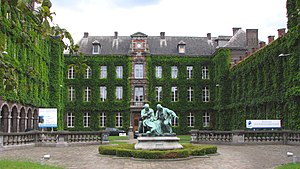Faculté polytechnique de Mons
| Faculté polytechnique de Mons | |
|---|---|
| activity | 1836 - December 31, 2008 |
| Sponsorship | state |
| place | Mons , Charleroi |
| country | Belgium |
| Rector | Calogero Conti |
| Students | about 1200 |
| Website | www.fpms.ac.be |
The Faculté Polytechnique de Mons (FPMs) was the oldest university in the Belgian city of Mons and the first engineering school in Belgium ( 1836 ). The faculty trained engineers (Master of Science (MSc)) in a five-year course , and a doctorate was also possible. On January 1, 2009, it went on together with the larger Université de Mons-Hainaut in the newly founded University of Mons .
history
In 1836, the governor of the province of Hainaut Jean-Baptiste Thorn recognized the need of the then changing industry for trained skilled foremen and engineers. On October 10, 1836, Thorn proposed the establishment of a corresponding (secondary) school to the Provincial Council, whereupon on October 21, 1836 the Provincial Council decided to establish the École Provinciale des Mines du Hainaut (German Mining School of the Province of Hainaut).
Thorn took the École centrale Paris as a model. At the École Provinciale des Mines du Hainaut , broadly trained specialists and, in later development, engineers were trained. The École Provinciale des Mines du Hainaut was the first engineering school to be decided in Belgium (1836). The École Provinciale des Mines du Hainaut began operations on November 1, 1837 in Mons on Rue des Ursulines in house number 5. At the same time, the École des Mines of the Université de Liège was founded in 1837 and the École du Génie Civil of the University of Ghent in 1838 .
After founding the École Provinciale des Mines du Hainaut ', Barthélemi-Adolphe Devillez was appointed rector after its introduction in Mons. His classmate from Paris, Théophile Guibal, later entered the service of this school.
It is not known when Rector Devillez and Guibal, engineering graduates from the École centrale Paris, were commissioned to create school programs for the “École Provinciale des Mines du Hainaut”. Initially, in the absence of such programs for the acceptance of students and for the school objectives, it was not easy for years to successfully implement the ideas as objectives. This was reflected in the number of students: in 1837 35 students attended the school and the number fell to 14 in 1844. In the mining training areas, excellent engineering training was still a long way off.
In 1845 the program was restructured and the courses were expanded. From then on, the school was called École de Commerce, d'Industrie et des Mines du Hainaut . The success of the training programs that have since been set up fell in the period that followed, which was accompanied by an increase in the number of students to over 100 in 1859. With the increase in the number of students to over 125 in 1874, the development of the extension of the study period from three to four years in 1876 goes hand in hand with the name Faculté Polytechnique du Hainaut . At the same time, it became apparent that more space was needed than was available on Rue des Ursulines.
In 1879 the school was reorganized to become the "Ecole des Mines de Mons" and the current historical building (formerly the Collège de Houdain) at 9 rue de Houdain was made available for this purpose. At this point, Théophile Guibal had already been retired for two years and was no longer involved in running the school at the Ecole des Mines de Mons . He died in 1888, while Rector Barthélemi-Adolphe Devillez, who did not retire until 1889, died three years later as Guibal.
During the First World War from 1914–1918 the school closed its doors. In 1920 the school was given legal status by the Belgian Parliament as the École des Mines et de Métallurgie, Faculté Technique de la Province de Hainaut . With the further development towards higher education, the school advanced to the Faculté Polytechnique de Mons in 1935 . Since then, it has been using this name as a faculty designation, even after the merger on January 1, 2009 with the larger Université de Mons-Hainaut to form the newly founded state, French-speaking Université de Mons (University of Mons).
Between 2004 and 2005 around 1200 students studied at the FPMs, of which around 170 graduate every year. The FPMs awarded the Bachelor of Science (BSc.) And Master of Science (MSc.) Degrees in architecture, chemistry and materials science, electricity, computer science (business administration), mechanics and mining. The FPMs also offer advanced studies and doctorates.
The FPMs had 25 research laboratories and 4 research centers (Multitel, Materia Nova, Inisma, CETIC). The FPMs was part of the ERASMUS program and maintained 25 direct partnerships with foreign universities. She was also a member of the TIME network ( Top Industrial Managers for Europe ). The FPMs awarded double degrees with the following institutes:
- technical University of Vienna
- Ecole Centrale de Lille
- École centrale de Lyon
- École centrale de Marseille
- Ecole centrale de Nantes
- École Nationale Supérieure de l'Aéronautique et de l'Espace
- École supérieure d'électricité
- Politecnico di Milano
- Universidad Politécnica de Madrid
On July 6, 2007, the boards of directors of the FPMs and the Université de Mons-Hainaut unanimously decided to merge to form the Université de Mons (2009–2010).
Well-known university professors
- Jules Cornet - geologist (1865-1929)
Web links
Individual evidence
- ↑ De l'École des Mines à la Faculté Polytechnique de Mons
- ↑ PROJET DE CREATION DE L'UNIVERSITE DE MONS. Press conference ( Memento of the original from July 29, 2007 in the Internet Archive ) Info: The archive link was inserted automatically and has not yet been checked. Please check the original and archive link according to the instructions and then remove this notice.


